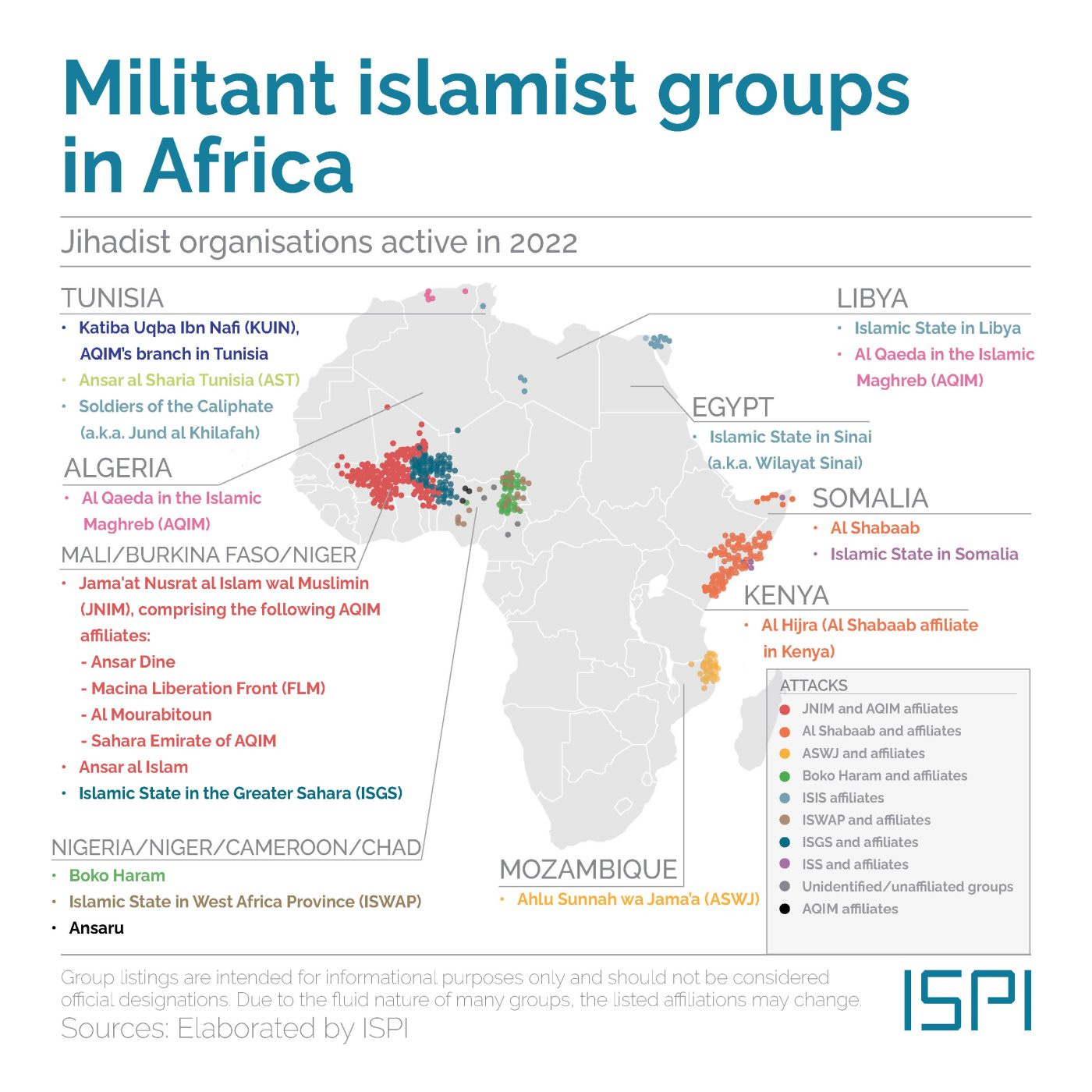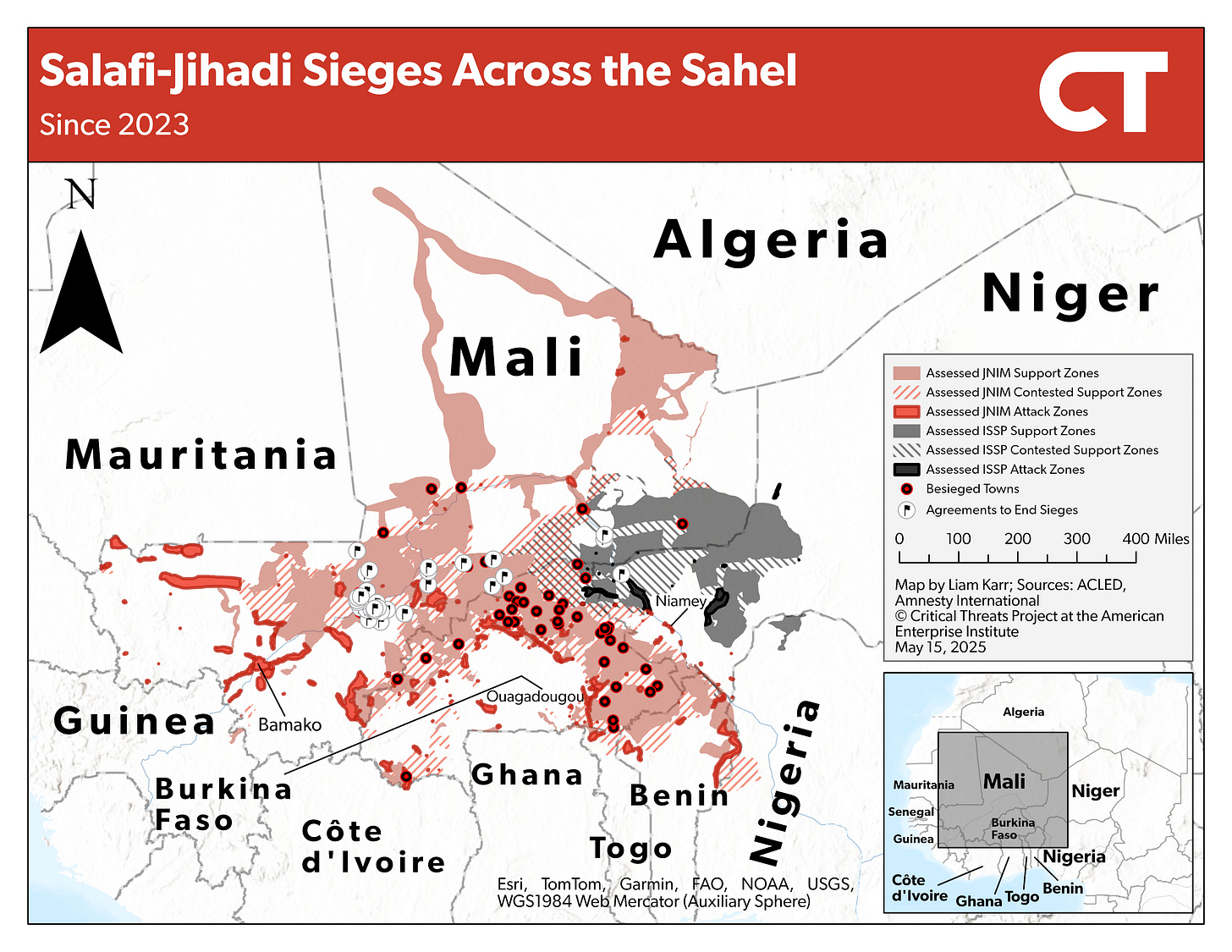THE SCOPE OF JIHADIST THREATS: THESE ARE THE TERRORIST GROUPS OPERATING IN THE SAHEL
The latest recorded figures show an unprecedented surge in terrorist attacks in at least three Sahel countries: Mali, Niger, and Burkina Faso.
Despite the efforts of the military junta leaders in Mali, Burkina Faso, and Niger, jihadist violence continues to rise due to instability and the policies of these three countries, which formed a confederation called the Alliance of the Gourma (AES). The AES countries focus their strategy on combating the Azawad movements in northern Mali instead of fighting the terrorist groups spread across regions near the capitals of these three countries. Extremist groups have transformed the African Sahel region into one of the world’s most prominent terrorism hotspots. The past three years have witnessed a significant and quantitative expansion of terrorist attacks. To understand this transformation, it is necessary to know the nature and composition of the main jihadist groups operating in the region.
The Most Prominent Jihadist Groups in Africa:
Uqba Ibn Naf’i Brigade: Affiliated with Al-Qaeda, with approximately 175 fighters, calling themselves “Soldiers of the Caliphate.”
Guardians of Salafism in Algeria: Pledged allegiance to Al-Qaeda in 2007. They rely on kidnapping foreigners to demand ransoms to fund their terrorist activities.
Soldiers of the Caliphate in Algeria: Pledged allegiance to ISIS, with an estimated 20 to 35 fighters.
Yunud al-Jilafa in Tunisia: A branch of ISIS. Its terrorist operations in Tunisia began in early 2015.
Al-Shabaab in Somalia: The U.S. State Department considers five Al-Shabaab leaders as specially designated global terrorists under Executive Order 13224.
Al-Shabaab in Mozambique: A terrorist group controlling several coastal areas, including the port of Mocimboa da Praia and gas facilities.
Boko Haram: The largest terrorist group active in northern Nigeria. Pledged allegiance to ISIS. Armed clashes between ISIS and Boko Haram increased in 2023 in Nigeria over control of the Lake Chad basin and its surroundings.
Jama’at Nusrat al-Islam (JNIM): An alliance of four Al-Qaeda-affiliated terrorist groups: Ansar Eddine, Al-Mourabitoun, Macina, and the Timbuktu Emirate (Sahara Brigades).
ISIS: The Islamic State is expanding into Nigeria, the Gulf of Guinea, and continues to raise financial and other resources to implement its jihadist agendas in the region.
Al-Qaeda: Active in two regions, the Sahel and the Horn of Africa. The goals of ISIS and Al-Qaeda in Africa are similar: to increase their influence and strengthen their presence in Africa.
Jama’at Nusrat al-Islam (JNIM) Is the Most Widespread Terrorist Group
The Group to Support Islam and Muslims (affiliated with Al-Qaeda), led by Iyad Ag Ghaly (Abu Al-Fadl), divides Mali into six military regions across the country:
Macina Region (Mopti), in the center, led by Amadou Koufa (Fulani).
Sahara Emirate Region (Timbuktu), in the west, led until March 11 by Talha Al Libi (Abu Hind).
Aribanda Region, on the Burkina Faso-Mali border, led by Abu Hamza Al-Chenguiti (a Mauritanian who died a week ago in an attack between Kidal and Timbuktu).
Menaka Region, in eastern Mali, led by Faknan Ag Taki (of Tuareg origin).
Gao Region, in northeastern Mali, led by Hamza Tabencourt.
Kidal Region, in the northernmost part, led by Sidan Ag Hita (Abou Outhmane Al Ansari).
Additionally, JNIM has two logistical support units: the Gourma Battalion and the Mima Battalion. These units provide logistical support for all terrorist operations and manage hostage cases, among other tasks.
Source: Liam Karr; Amnesty International; Armed Conflict Location and Event Data.
These are the main jihadist factions operating in the Sahel under the umbrella of Al-Qaeda, led by Algerian Abu Oubaida Yusef Al Annabi:
Ansar Eddine: Its main base is in Kidal, extending to Tinzawaten on the Algerian border. Recently, this faction created four new light military units.
Macina, also called the Macina Liberation Front: The largest faction, led by Amadou Koufa. It controls the region stretching from southwestern Timbuktu to Burkina Faso and Guinea, passing through the Mopti region in central Mali.
Khaled bin Al-Walid Battalion, known as Ansar Eddine of the South, led by Suleiman Keita. It operates from eastern Bamako to the Burkina Faso border.
Niger River South Brigade, led by Al Mansour Ag Alghassam. Its area of influence extends from southern Timbuktu to Mopti in central Mali.
Ongoing Clashes Between ISIS in the Greater Sahara (Wilaya Sahel), Al-Qaeda, and Boko Haram for Regional Influence
The border region between Niger, Burkina Faso, and Mali is described as “the most dangerous triangle,” where terrorist organizations are highly active and launch attacks in the three countries from the Gourma-Liptako region.
These organizations have intensified their attacks, especially after the military coup in Niger in October 2023. ISIS (Wilaya Sahel) has become a significant player in the three-border region, imposing its agenda and controlling large areas in northeastern Mali and western Burkina Faso. Terrorist activities and attacks by ISIS (Wilaya Sahel) are mostly recorded in Menaka, Niger, and areas under its influence in Tillaberi (western Niger). Its activity has begun to spread to Atlantic countries like Benin, Togo, and Côte d'Ivoire. Al-Qaeda-affiliated groups are also expanding into sub-Saharan Africa, including West African countries like Benin, where extremist activity is concentrated in the north, with Al-Qaeda-affiliated groups attempting to recruit new fighters.
Boko Haram emerged in 2014 after the kidnapping of 276 girls in Chibok, northeastern Nigeria. However, the group was founded in 2002 under Muhammad Youssef, a Salafist preacher. Initially, it targeted corruption and inequality, which it attributed to British colonialism. Over time, it began fighting to impose Islamic Sharia in Nigeria. Abubakar Shekau succeeded Yusuf after his death, ushering in the group’s most violent phase. “I enjoy killing those God commands me to kill, just as I enjoy killing chickens and rams,” Shekau said in a 2012 video, two years before the kidnapping of 280 girls, which was condemned by the international community. In addition to kidnapping minors for indoctrination or use as child soldiers or sex slaves, Boko Haram has carried out attacks and massacres across Nigeria. According to the United Nations, over 35,000 people have been killed by this terrorist group, which is responsible for 40% of terrorist attacks in the Sahel. These massacres have also caused significant displacement. In 2014, Boko Haram declared a caliphate in Africa and pledged allegiance to ISIS in 2015. However, in 2016, ideological and strategic differences led to a split, resulting in the emergence of ISWAP (Islamic State West Africa Province).
Shekau’s Killing Gave ISWAP Freedom to Increase Its Influence
Shekau was killed in an ambush on May 19, 2021, by ISIS leaders from Syria, who accused him of “indiscriminately attacking believers.” The task was entrusted to ISWAP, led by Abu Musab al-Barnawi, son of Boko Haram’s founder, Muhammad Yusuf. Al-Barnawi’s group exploited the chaos within its rival to expand its influence. ISWAP may pose a greater threat to Nigerian authorities because it causes less terror among civilians than Boko Haram. “They provide some degree of law and order in the Lake Chad region, and civilians go there for business or to live due to the presence of productive agricultural land,” says Vincent Foucher, a senior analyst at the French Center for Scientific Studies and Research. Unlike Boko Haram, which killed those who did not join its ranks, ISWAP seeks to gain civilian trust and has not engaged in massacres or looting on the scale of its rival. “Most of ISWAP’s efforts have been to create an ecosystem where they exert strong control over the economy, justice, education, and security.”
Links Between Terrorist Groups and Drug Trafficking
ISWAP is also attempting to negotiate with Al-Qaeda-affiliated militias in the region, such as Jama’at Nusrat al-Islam wal Muslimin (JNIM). This group also receives support from other jihadist organizations based in Maghreb countries. Both ISIS and Al-Qaeda seek new funding sources, competing for areas with significant natural resources or strategically important locations. Some of these key areas are located along illicit trade routes, such as drug trafficking or human trafficking. As seen in Afghanistan and Pakistan since the 1990s, where the opium trade has been linked to Al-Qaeda and the Taliban, terrorists in the Sahel may be involved in drug trafficking from Morocco through Mauritania.




